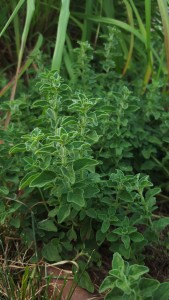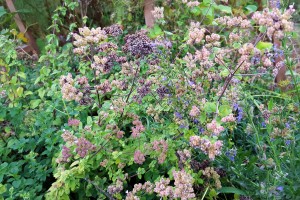
Greek Oregano
Oregano, a beloved ingredient in Italian cuisine, is one of the most popular herbs grown in culinary gardens. It is a Mediterranean plant that was also found in western and southwestern Asia.
Oregano was introduced to North America only recently. After World War II, returning GI’s brought it home, calling it the Pizza Herb. It is so hardy that it has escaped our gardens and naturalized in North America where it is perennial in zones 5 through 9.
People often complain that the oregano they purchase for their herb gardens has little or no taste. That’s because there are different types of oregano. The common oregano plant, Origanum vulgare, is usually labelled “oregano” and has little or no taste. Italian oregano (O. v. subsp. hirtum) is the oregano commonly used in Italian cuisine. Spicy oreganos include Greek oregano and Hot and Spicy Oregano (O. v. ‘Hot & Spicy’).
True to its Mediterranean origins, oregano grows best in lean, well-drained soil. It prefers to be dry. Too much water will reduce the flavor. Compost provides sufficient fertilizer. Too much fertilizer will also negatively affect the flavor.
Depending on the variety of oregano you are growing, the plants should reach a height of 30 inches if left unpruned or unharvested. Once the plants are 4 to 5 inches tall, you can begin harvesting. Most people wait to harvest their oregano until right before it flowers in late spring when the flavor is at its peak. Then they cut it to the ground. New growth should start to appear in a couple of weeks. Your oregano will continue to grow until the first frost. You should do a final harvest right before your first frost, cutting the stems down to the ground again, rather than allowing the foliage to die from the frost.
Drying oregano after harvest results in intense flavor, more intense than fresh oregano. When using oregano in a recipe, add dried oregano to your food while it is cooking. Add fresh oregano at the end of the cooking time because heating it for too long will make it bitter.

Oregano Flowers
Oregano flowers are also edible. Depending on the variety, they range in color from purple to pink to white. They usually appear in late spring. The flavor in the leaves starts to decline as the plants bloom, so most gardeners do not allow their oregano to bloom. In the case of Greek oregano, the leaves become very bitter after the plants have bloomed.
Oregano is easily grown from seed, however, because different varieties readily cross-pollinate, you may not get the oregano that you wanted. The seeds can be started indoors 6 to 10 weeks before your last frost date. They need some light to germinate so barely cover your seeds. You can plant your seedlings outdoors once the temperature remains steadily above 45⁰F.
If you want to direct sow your seeds in your garden, wait until after your last frost date to plant them, barely covered, outdoors. Germination will occur when the soil temperature reaches 70⁰F.
Oregano can also be grown from cuttings. This is the most reliable way to get the oregano that you want. You can either start your cuttings indoors 6 to 10 weeks before your last frost date or outdoors once the soil temperatures reach 70⁰F.

